This step by step diy project is about 12×16 ATV shed roof plans. This article is about how to build the roof for the 12×16 shed. The roof has generous overhangs so you can have a nice shed in your backyard. Don’t forget to check PART 1 of the project, so you learn how to frame the shed. Take a look over the rest of my woodworking plans, if you want to get more building inspiration.
When buying the lumber, you should select the planks with great care, making sure they are straight and without any visible flaws (cracks, knots, twists, decay). Investing in cedar or other weather resistant lumber is a good idea, as it will pay off on the long run. Use a spirit level to plumb and align the components, before inserting the galvanized screws, otherwise the project won’t have a symmetrical look. If you have all the materials and tools required for the project, you could get the job done in about a day. See all my Premium Plans HERE.
12×16 ATV Shed Roof Plans
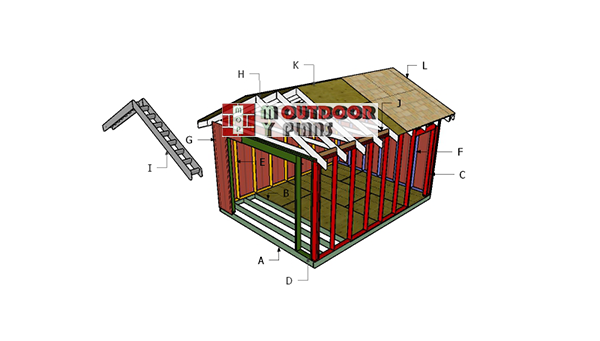
Building-an-atv-shed
Cut & Shopping Lists
- G – 4 pieces of T1-11 siding – 26 1/2″x48″ long, 2 pieces – 37 3/4″x48″ long SIDING
- H – 9 pieces of 2×4 lumber – 135 1/2″ long, 18 pieces of 2×6 lumber – 92 1/2″ long TRUSSES
- I – 8 pieces of 2×6 lumber – 12 1/2″ long, 64 pieces of 2×4 lumber – 7″ long OVERHANGS
- J – 4 pieces of 2×4 lumber – 21 3/4″ long, 12 pieces – 22 1/2″ long BLOCKINGS
- K – 4 pieces of 3/4″ plywood – 48″x96″ long, 4 pieces – 42″x48″ long, 2 pieces – 42″x96″ long, 4 pieces – 10 1/2″x90″ long ROOF
- L – 300 sq of tar paper, 300 sq of asphalt shingles ROOFING
- 9 pieces of 2×4 lumber – 12′
- 18 pieces of 2×6 lumber – 8″
- 4 pieces of 2×4 lumber – 8′
- 3 pieces of T1-11 siding
- 9 pieces of 3/4″ plywood – 4’x8′
- 2 1/2″ screws, 3 1/2″ screws, 1 5/8″ screws
- 4d nails
- wood filler , wood glue, stain/paint
- roll up door
- 300 sq of tar paper, 300 sq of asphalt shingles
Tools
![]() Hammer, Tape measure, Framing square, Level
Hammer, Tape measure, Framing square, Level
![]() Miter saw, Drill machinery, Screwdriver, Sander
Miter saw, Drill machinery, Screwdriver, Sander
Time
Related
- PART 1: ATV Shed Plans
- PART 2: ATV Shed Roof Plans
- PART 3: Ramp ATV Shed Plans
Building an atv shed roof

Building-the-shed-rafters
Build the rafters for the 12×16 atv roof. Mark the cut lines on the rafters and then get the job done with a circular saw. Make 25 degree cuts to both ends of the rafters. Smooth the cut edges with sandpaper.
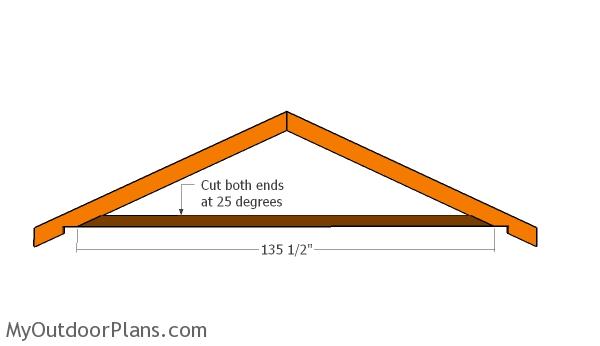
Assembling-the-trusses
Build the bottom rafters from 2×4 lumber. Make 65 degree cuts to both ends of the rafters. Assemble the trusses by laying them first on a level surface. Use metal plates to lock the rafters together tightly. In addition, leave no gaps between the components
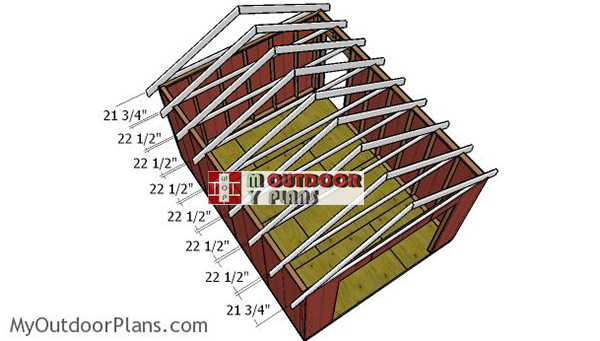
Attach the trusses to the top of the shed, every 24″ on center. Use a spirit level to plumb the trusses. Use hurricane ties to secure the trusses to the top plates.
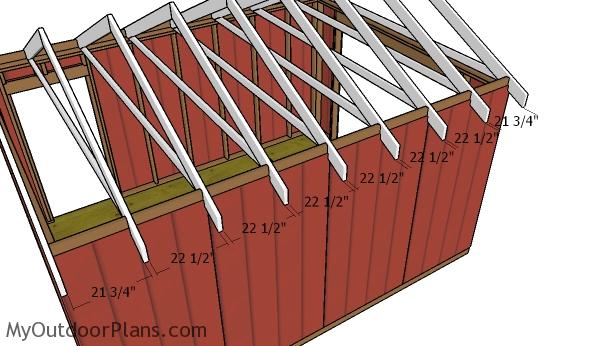
Fitting-the-roof-blockings
Fit 2×4 blockings to the top of the roof between the rafters. Drill pocket holes at both ends of the blocking and secure them into place with 2 1/2″ screws.
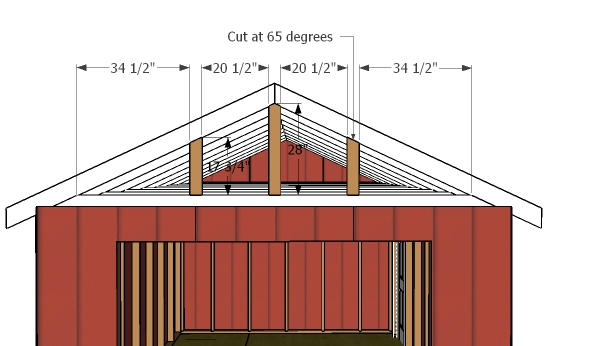
Gable-end-supports
Attach the 2×4 supports to the gable ends, so you can attach the siding panels later on.

Attaching-the-gable-ends
Attach 5/8″ T1-11 siding panels to the gable ends, after making the cuts. Use 4d nails to hang the panels into place tightly.
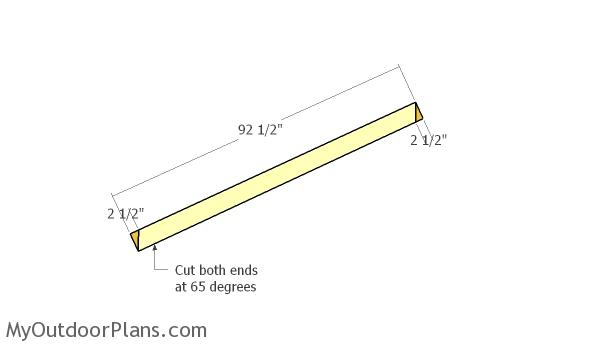
Building-the-rafters
Build the rafters for the overhangs. Make the miter cuts to the 2×6 beams.

Assembling-the-overhangs
Assemble the overhnags by fitting the 2×4 blockings. Drill pilot holes through the rafters and insert 2 1/2″ screws into the blockings.

Fitting-the-overhangs
Attach the overhangs to the gable ends, after aligning the edges with attention. Drill pilot holes through the overhangs and insert 3 1/2″ screws into the supports.
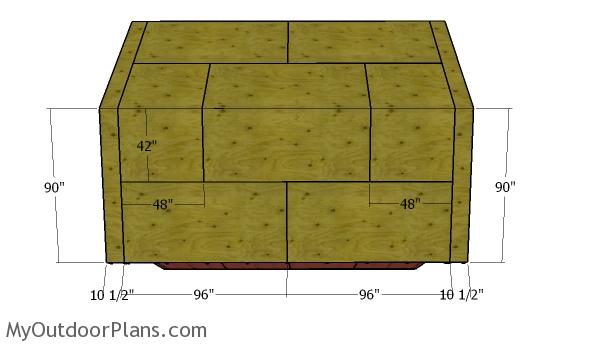
Fitting-the-roof
Attach the 3/4″ plywood sheets to the roof of the lean to shed. Align the edges flush and secure them to the rafters using 1 5/8″ screws. Make sure there are no gaps between the sheets for a professional result.

Fitting-the-side-trims
Attach 1×6 trims to the sides of the ATV shed. Align the edges with attention and secure them to the end of the rafters with 1 1/2″ bard nails.
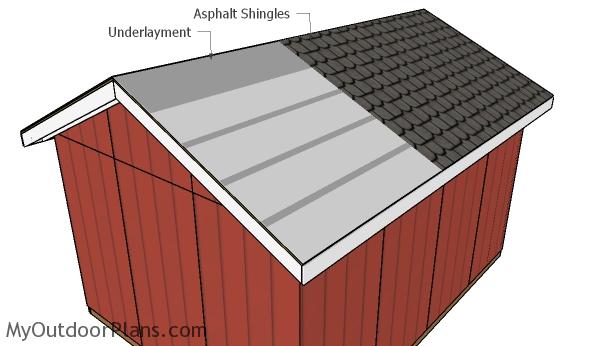
Fitting-the-roofing
Cover the roof of the shed with roofing felt, making sure the strips overlap at least 2″. Secure the tar paper to the plywood sheets with roofing staples. Fit the side drip edges over the roofing felt, while the bottom drip edges should be fit under. Afterwards, attach the asphalt shingles to the roof, starting with the left bottom side of the roof. Read the manufacturer’s instructions to understand how to install the shingles into place properly.
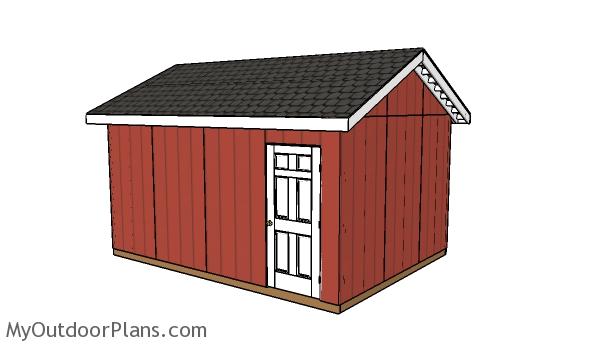
12×16-atv-shed-plans
Hand the side door, as well as the roll up front door to the front wall. Fill the holes with wood putty and then smooth the surface with 120-220 grit sandpaper. Apply a few coats of paint or stain to enhance the look of the 12×16 shed.
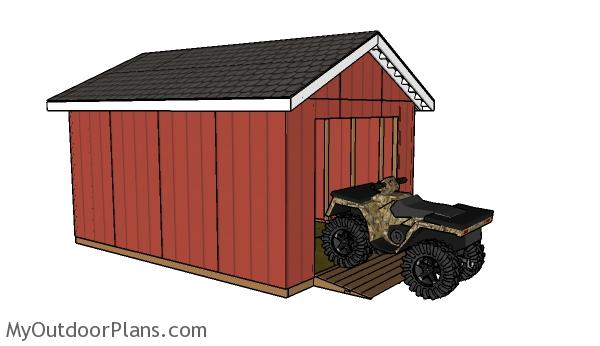
DIY-atv-shed
This atv shed is really nice, as it gives you the opportunity to store lots of large items inside starting with a motorbike up to an ATV. Check out PART 1 of the project to learn more on how to build the shed frame.
This woodworking project was about atv shed plans free. If you want to see more outdoor plans, check out the rest of our step by step projects and follow the instructions to obtain a professional result.
 |
 |
EXPLORE MORE IDEAS FOR:
 |
 |
 |
 |

2 comments
I am building the ATV shed. All is good so far, but I am confused as to where the roof blockings go and what they are for.
Fitting-the-roof-blockings
Fit 2×4 blockings to the top of the roof between the rafters. Drill pocket holes at both ends of the blocking and secure them into place with 2 1/2″ screws.
Can you help?
TJ
Those are pieces of lumber used to block the gapes created between the walls and roof, so you stop the air from getting inside.